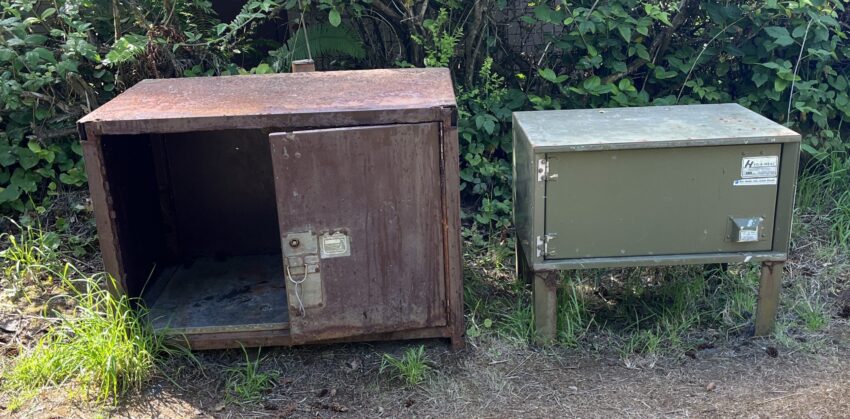During a 20-week break between jobs this summer, I managed to put 25,000 miles on my vehicle with four big trips to the West and several others in the Great Lakes region!
All of that travel turned up a lot of quirks and weirdness. I’ve mentioned some of it in previous Off Topic columns, but here are some other random observations I haven’t gotten to:
Bear spray: Required in Yellowstone. Recommended in the North Cascades. Illegal in Yosemite.

Bear lockers: Preventing bears from associating humans with food is a real problem for parks, but they have inconsistent ways of dealing with the problem. Some parks, such as the North Cascades complex (left), give you the option of keeping food in your vehicle or putting it in a bearproof food locker. At Yosemite and other northern California parks, you are required to remove all food and scented items from your vehicle and put them in the bear locker, even if you’re at a walk-in site. But at national forest campgrounds near Crater Lake and Mount Rainier, where there are surely many bears, there are no bear lockers at all.
Recycling: West of Minnesota, it was almost impossible to find recycling bins. It almost seemed as if Nebraska rest stops were taunting me with dozens of garbage cans but no place to drop my pop cans. Even more surprising was that Washington state, with its environmental reputation, did not have any recycling bins at the rest areas where I stopped. Some did not even have garbage cans. I ended up filling a Space Needle shopping bag with recycling that came all the way back home.
Construction zones: Most drivers seem to ignore construction zone speed limits completely. In California, some drivers honked to complain because I was travelling at the work zone speed limit. In Wyoming, a guy in a big pickup tailgated and flashed his lights because I was getting in his way by obeying the law. In Texas, four semi trucks in a row passed me in a no-passing work zone!

Out of order: I encountered many rest areas that were closed for repairs or other issues. Some were marked as closed on the interstate, but not all. One in South Dakota had a handwritten cardboard sign hanging in the door. Another in Wyoming had an official sign, suggesting that they weren’t in a hurry to get it fixed.
Friendly convicts: I was surprised to encounter people wearing orange prison jumpsuits as I went to the restroom at an Arizona state park. Apparently they’re the cleaning crew, and Arizonans are comfortable with the idea of prisoners freely wandering around the park.
Border inspections: No, I didn’t cross into Mexico or Canada. But when you enter California, you have to pull over to an inspection station to answer questions about the fruit and vegetables you might be carrying. I crossed into the state several times this year but didn’t get searched.
Weather forecasts: It’s incredibly difficult to get an accurate forecast before you reach a national park campground in the West. Most of them are far from any town you can find in a weather app (when you have service). Since most of them are in mountainous areas, the weather varies greatly depending on the elevation, so a forecast from the radio is no help.

Wide temperature swings: It’s no surprise that the mountains, valleys, coasts, and deserts have wildly different temperatures. But I wasn’t expecting 40-degree weather when I camped on the California coast in May. Days later, I camped in 100-degree temperatures in the Sonoran Desert. In June, I changed hiking plans at Great Basin National Park because of ice. A week later, I canceled a night at Pinnacles National Park because of heat. In July, I wore my fall clothes at Redwood National Park days after sweating it out at Lava Beds National Monument. In late August, I was surprised to arrive at my campsite in the North Cascades, near the Canadian border, to find 95-degree weather that knocked me down for a while.
Queuing: The British are very proud of their ability to line up, but national park visitors are experts. Lines to get into the park. Circling the parking lot to find a space. Lines to get into the restroom. Lines to get to the snack bar. Lines to get to the register. You must remember to plan your bathroom breaks far in advance, and line up for lunch soon after breakfast.
Convenience stores: They don’t seem to be as convenient out West. I was looking for the big stores with lots of snacks and restrooms like we have in the Midwest, but they were a rare site during my four journeys through California, Oregon, and Washington state. (And Oregon doesn’t let you pump your own gas.) Chain truck stops were the best option, when I could find them.
Four bags of ice in one: Safeway puts three plastic bags of ice inside of a bag of ice. But they’ll also sell you a reusable shopping bag to reduce plastic pollution.
Forgotten in the fridge: I left a half-eaten bag of pepperoni in a Tucson hotel fridge. But the people at a Boise hotel must have been more puzzled to find a half-thawed frozen dinner in the fridge. I’d bought it not realizing there wasn’t a microwave in the room and thought maybe I’d cook it later at a campsite, but forgot it.
Fast Food Conversion Chart:
| West | Midwest |
| In-N-Out Burger | Culver’s Double Deluxe |
| Del Taco | Taco Bell with fries |
| El Pollo Loco | Taco Bell + KFC |
| Taco Time | Taco John’s |
| Jack in the Box | McDonald’s |
| Arctic Circle | Dairy Queen |
Also, check out my musings about hotel TV’s if you haven’t seen them!

